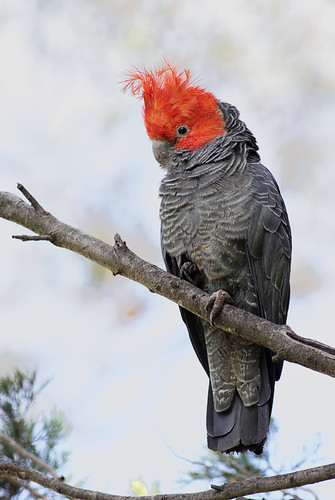Canberra a city dominated by galahs
 Sunday, April 1, 2012 at 13:35
Sunday, April 1, 2012 at 13:35
 Sunday, April 1, 2012 at 13:35
Sunday, April 1, 2012 at 13:35  Wednesday, August 3, 2011 at 1:50
Wednesday, August 3, 2011 at 1:50  Saturday, May 21, 2011 at 7:57
Saturday, May 21, 2011 at 7:57  Gang gang cockatoo. Photo: Leo 0ystercatcherBIRDWATCHERS are being encouraged to keep an eye out for one of Hornsby’s most distinctive residents.
Gang gang cockatoo. Photo: Leo 0ystercatcherBIRDWATCHERS are being encouraged to keep an eye out for one of Hornsby’s most distinctive residents.
Hornsby Council wants residents to report sightings of the gang-gang cockatoo, which has a scarlet head and slate-grey body.
The council’s environmental scientist Alex Fraser said the bird’s habitat was mainly in the Pennant Hills, Thornleigh, Beecroft, Epping and Cheltenham areas. Similar in size to a galah, they have a call resembling a creaky hinge.
Gang gang cockatoos predominantly feed on plants, fruits, berries, insects and larvae.
 Monday, April 18, 2011 at 3:10
Monday, April 18, 2011 at 3:10  The palm cockatoo, a large species of parrot from Papua New Guinea and Australia, has been dethroned as the common ancestor of the cockatoo family by a new genetic study that has redrawn the family's evolutionary history. Photo: lil moe72SYDNEY: In a study that could dissuade breeders from illegally smuggling parrot eggs, the DNA code of the cockatoo mitochondrial genome has been pieced together, revealing the surprising evolutionary history of these large, native Australasian birds.
The palm cockatoo, a large species of parrot from Papua New Guinea and Australia, has been dethroned as the common ancestor of the cockatoo family by a new genetic study that has redrawn the family's evolutionary history. Photo: lil moe72SYDNEY: In a study that could dissuade breeders from illegally smuggling parrot eggs, the DNA code of the cockatoo mitochondrial genome has been pieced together, revealing the surprising evolutionary history of these large, native Australasian birds.
 Tuesday, April 5, 2011 at 8:34
Tuesday, April 5, 2011 at 8:34  Callocephalon fimbriatum - Gang-gang Cockatoo,
Callocephalon fimbriatum - Gang-gang Cockatoo,  Calyptorhynchus banksii - Red-tailed Black Cockatoo,
Calyptorhynchus banksii - Red-tailed Black Cockatoo,  Calyptorhynchus baudinii - Baudin Cockatoo,
Calyptorhynchus baudinii - Baudin Cockatoo,  Calyptorhynchus funereus - Yellow-tailed Black Cockatoo,
Calyptorhynchus funereus - Yellow-tailed Black Cockatoo,  Calyptorhynchus latirostris - Carnaby's Cockatoo,
Calyptorhynchus latirostris - Carnaby's Cockatoo,  Eolophus roseicapilla - Galah,
Eolophus roseicapilla - Galah,  Probosciger aterrimus - Palm Cockatoo | in
Probosciger aterrimus - Palm Cockatoo | in  Research
Research